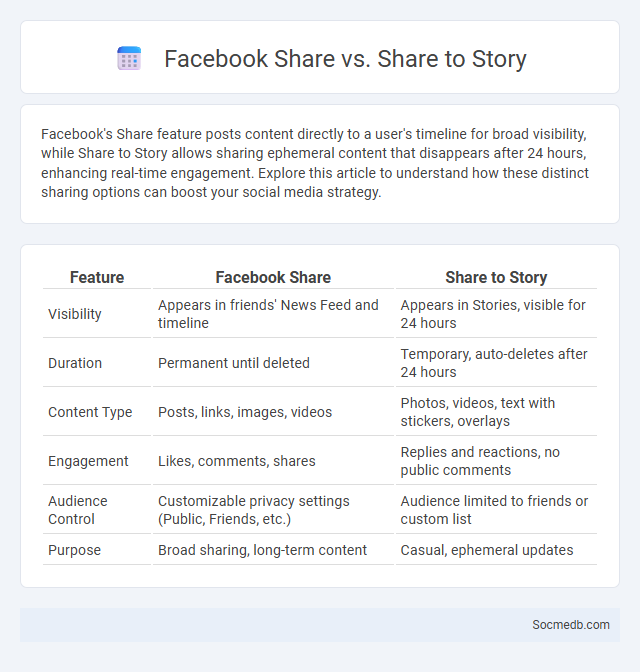
Photo illustration: Facebook Share vs Share to Story
Facebook's Share feature posts content directly to a user's timeline for broad visibility, while Share to Story allows sharing ephemeral content that disappears after 24 hours, enhancing real-time engagement. Explore this article to understand how these distinct sharing options can boost your social media strategy.
Table of Comparison
| Feature | Facebook Share | Share to Story |
|---|---|---|
| Visibility | Appears in friends' News Feed and timeline | Appears in Stories, visible for 24 hours |
| Duration | Permanent until deleted | Temporary, auto-deletes after 24 hours |
| Content Type | Posts, links, images, videos | Photos, videos, text with stickers, overlays |
| Engagement | Likes, comments, shares | Replies and reactions, no public comments |
| Audience Control | Customizable privacy settings (Public, Friends, etc.) | Audience limited to friends or custom list |
| Purpose | Broad sharing, long-term content | Casual, ephemeral updates |
Understanding Facebook Sharing Options
Facebook sharing options include Public, Friends, Friends except..., Specific friends, and Only me settings, allowing users to control who sees their posts. Customizing privacy settings enhances content visibility management and protects personal information from unwanted viewers. Understanding these options is essential for maximizing engagement and maintaining online privacy on Facebook.
What is Facebook "Share"?
Facebook "Share" is a feature that allows users to distribute content such as posts, photos, videos, or links directly to their own timeline or friends' feeds, amplifying reach and engagement. This interactive function supports viral marketing by enabling seamless content propagation across the platform's vast network of over 3 billion monthly active users. By leveraging algorithm-driven visibility, the Share button exponentially increases the potential audience for individual content, boosting brand awareness and social interaction.
What Does "Share to Story" Mean on Facebook?
Share to Story" on Facebook allows you to post photos, videos, or text updates that appear temporarily at the top of your friends' feeds for 24 hours. This feature helps you highlight moments, updates, or promotions in a more engaging and ephemeral way. You can personalize your Story with stickers, filters, and text to make your content stand out.
Facebook Share vs. Share to Story: Key Differences
Facebook Share allows users to repost content directly to their news feed, making it visible to friends and followers within their timeline. Share to Story enables temporary content sharing that lasts 24 hours, appearing at the top of friends' feeds and emphasizing immediacy and casual updates. The primary difference lies in permanence and audience engagement, with Share targeting ongoing interaction and Stories focusing on short-lived, ephemeral visibility.
Audience Reach: Share vs. Share to Story
Sharing a post directly to your audience feed increases content visibility and engagement through likes, comments, and shares, targeting your established followers. Using the "Share to Story" feature boosts real-time interaction by placing the content prominently at the top of your followers' feeds, appealing to both current and potential new viewers. Your choice between "Share" and "Share to Story" impacts the breadth and immediacy of audience reach, tailoring interaction based on your social media strategy goals.
Engagement Metrics: Which Sharing Option Performs Best?
Engagement metrics such as likes, comments, shares, and click-through rates reveal that sharing options on social media platforms differ significantly in performance. Video posts typically generate higher interaction rates, with Instagram Reels and TikTok videos outperforming static images and text-based posts by up to 30-40% in engagement. Data from Facebook and LinkedIn indicate that personalized sharing options, like direct messaging and group shares, increase post visibility and user interaction more effectively than public sharing.
Privacy Controls: Comparing Facebook Sharing Features
Facebook offers a range of privacy controls allowing users to customize who can see their posts, including options like Public, Friends, Friends except, Specific friends, and Only me. Users can also manage sharing settings for individual posts and adjust default audience preferences to enhance content privacy. Advanced features include activity log review, blocking, and timeline review to ensure precise control over shared information.
Content Visibility after Sharing
Content visibility after sharing on social media platforms depends heavily on engagement metrics such as likes, comments, and shares, which signal relevance to algorithms. Optimizing content with targeted keywords, hashtags, and high-quality visuals enhances discoverability and encourages wider audience interaction. Timely posting during peak user activity further increases the likelihood of content appearing prominently in feeds and trending sections.
Best Practices for Facebook Sharing Options
Optimizing Facebook sharing options involves selecting appropriate privacy settings to target the desired audience effectively, utilizing compelling preview images and descriptive text to increase engagement, and enabling link sharing with clear calls to action. Implementing Open Graph tags enhances content presentation, ensuring shared posts appear consistently across devices. Monitoring analytics data helps refine sharing strategies, boosting reach and interaction rates on Facebook.
When to Use Each Facebook Sharing Feature
Facebook's sharing features serve distinct purposes based on content and audience; use the News Feed for personal updates and engaging stories, Stories for ephemeral, real-time moments, and Groups to target specific communities with relevant discussions. Sharing via Marketplace is ideal for selling items locally while Events facilitate promotion and coordination of upcoming activities or gatherings. Selecting the right feature maximizes reach, engagement, and relevance according to the nature of your message and intended viewers.
 socmedb.com
socmedb.com